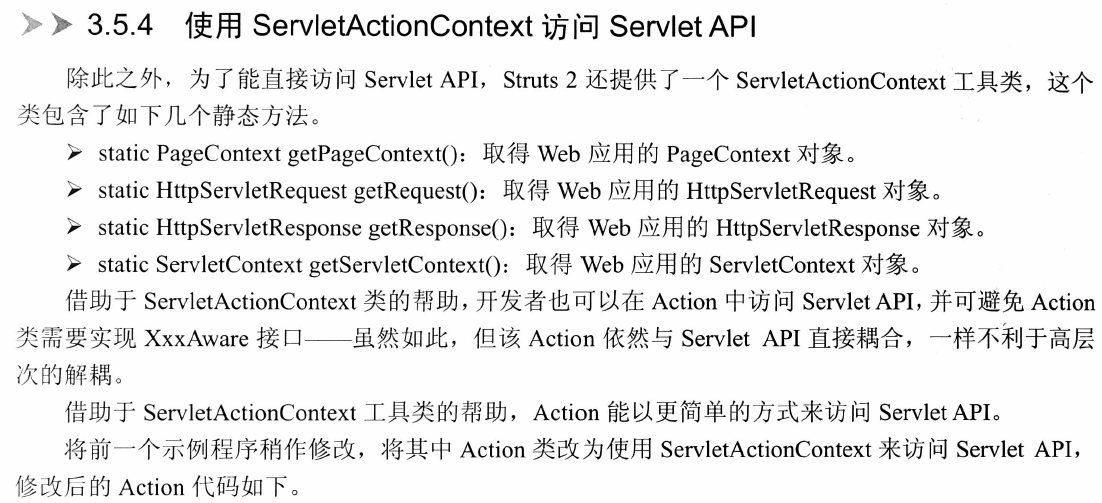Action访问servlet API
1、通过ActionContext
Action处理类:
package com.crazyit.app.action; import javax.servlet.http.HttpServletRequest; import org.apache.struts2.convention.annotation.*; import com.opensymphony.xwork2.ActionContext; import com.opensymphony.xwork2.ActionSupport; @Namespace("/") @Results({ @Result(name="success",location="/WEB-INF/content/welcome.jsp") }) public class loginAction extends ActionSupport{ private String username; private String password; public String getUsername() { return username; } public void setUsername(String username) { this.username = username; } public String getPassword() { return password; } public void setPassword(String password) { this.password = password; } @Override public String execute() throws Exception { if("lidian".equals(username) && "123".equals(password)) { return SUCCESS; }else { return ERROR; } } @Action("login") public String login() throws Exception{ if("lidian".equals(username) && "123".equals(password)) { /*设置application范围内属性*/ ActionContext.getContext().getApplication().put("counter", 1); /*设置session范围内属性*/ ActionContext.getContext().getSession().put("username", username); /*设置request范围内属性*/ ActionContext.getContext().put("tip", "您已经登陆"); return SUCCESS; }else { return ERROR; } } }
jsp访问数据:
<%@ page language="java" contentType="text/html; charset=UTF-8" pageEncoding="UTF-8"%> <%@taglib prefix="s" uri="/struts-tags" %> <!DOCTYPE html PUBLIC "-//W3C//DTD HTML 4.01 Transitional//EN" "http://www.w3.org/TR/html4/loose.dtd"> <html> <head> <meta http-equiv="Content-Type" content="text/html; charset=UTF-8"> <title>welcome</title> </head> <body> <h1>欢迎,${sessionScope.username }</h1> <h2>当前访问量:${applicationScope.counter }</h2> <h3>提示消息:${requestScope.tip }</h3> </body> </html>
2、Action直接访问servlet API

Action类代码:
package com.crazyit.app.action; import javax.servlet.ServletContext; import javax.servlet.http.Cookie; import javax.servlet.http.HttpServletRequest; import javax.servlet.http.HttpServletResponse; import org.apache.struts2.convention.annotation.*; import org.apache.struts2.interceptor.ServletResponseAware; import org.apache.struts2.util.ServletContextAware; import com.opensymphony.xwork2.ActionContext; import com.opensymphony.xwork2.ActionSupport; @Namespace("/") @Results({ @Result(name="success",location="/WEB-INF/content/welcome.jsp") }) public class loginAction extends ActionSupport implements ServletResponseAware{ private String username; private String password; private HttpServletResponse response; public String getUsername() { return username; } public void setUsername(String username) { this.username = username; } public String getPassword() { return password; } public void setPassword(String password) { this.password = password; } @Override public void setServletResponse(HttpServletResponse response) { this.response = response; } @Override public String execute() throws Exception { if("lidian".equals(username) && "123".equals(password)) { return SUCCESS; }else { return ERROR; } } @Action("login") public String login() throws Exception{ if("lidian".equals(username) && "123".equals(password)) { /*设置application范围内属性*/ ActionContext.getContext().getApplication().put("counter", 1); /*设置session范围内属性*/ ActionContext.getContext().getSession().put("username", username); /*设置request范围内属性*/ ActionContext.getContext().put("tip", "您已经登陆"); Cookie c = new Cookie("user", getUsername()); c.setMaxAge(60 * 15); response.addCookie(c); return SUCCESS; }else { return ERROR; } } }
jsp画面,获取值:
<%@ page language="java" contentType="text/html; charset=UTF-8" pageEncoding="UTF-8"%> <%@taglib prefix="s" uri="/struts-tags" %> <!DOCTYPE html PUBLIC "-//W3C//DTD HTML 4.01 Transitional//EN" "http://www.w3.org/TR/html4/loose.dtd"> <html> <head> <meta http-equiv="Content-Type" content="text/html; charset=UTF-8"> <title>welcome</title> </head> <body> <h1>欢迎,${sessionScope.username }</h1> <h2>当前访问量:${applicationScope.counter }</h2> <h3>提示消息:${requestScope.tip }</h3> <h3>实现Aware接口的cookie的值: ${cookie.user.value }</h3> </body> </html>
3、Action直接访问servlet API的另外一种方式

package com.crazyit.app.action; import javax.servlet.http.Cookie; import javax.servlet.http.HttpServletResponse; import org.apache.struts2.ServletActionContext; import org.apache.struts2.convention.annotation.*; import org.apache.struts2.interceptor.ServletResponseAware; import com.opensymphony.xwork2.ActionContext; import com.opensymphony.xwork2.ActionSupport; @Namespace("/") @Results({ @Result(name="success",location="/WEB-INF/content/welcome.jsp") }) public class loginAction extends ActionSupport implements ServletResponseAware{ private String username; private String password; private HttpServletResponse response; public String getUsername() { return username; } public void setUsername(String username) { this.username = username; } public String getPassword() { return password; } public void setPassword(String password) { this.password = password; } @Override public void setServletResponse(HttpServletResponse response) { this.response = response; } @Override public String execute() throws Exception { if("lidian".equals(username) && "123".equals(password)) { return SUCCESS; }else { return ERROR; } } @Action("login") public String login() throws Exception{ if("lidian".equals(username) && "123".equals(password)) { /*设置application范围内属性*/ ActionContext.getContext().getApplication().put("counter", 1); /*设置session范围内属性*/ ActionContext.getContext().getSession().put("username", username); /*设置request范围内属性*/ ActionContext.getContext().put("tip", "您已经登陆"); Cookie c = new Cookie("user", getUsername()); c.setMaxAge(60 * 15); //response.addCookie(c); ServletActionContext.getResponse().addCookie(c); return SUCCESS; }else { return ERROR; } } }




